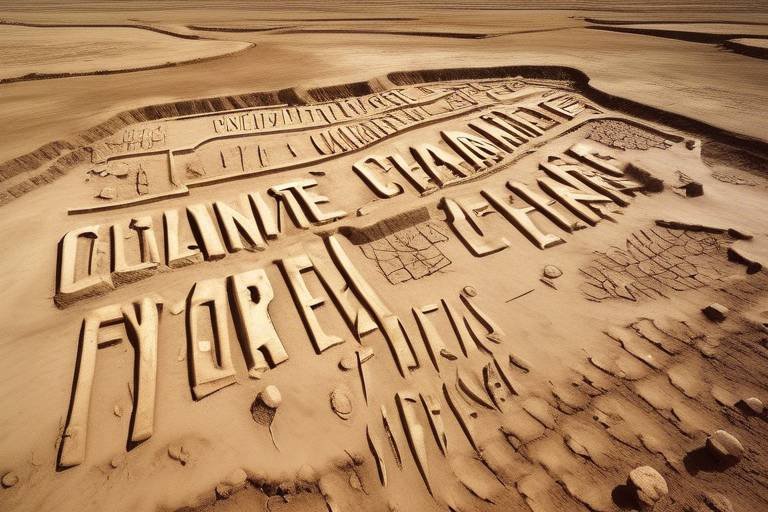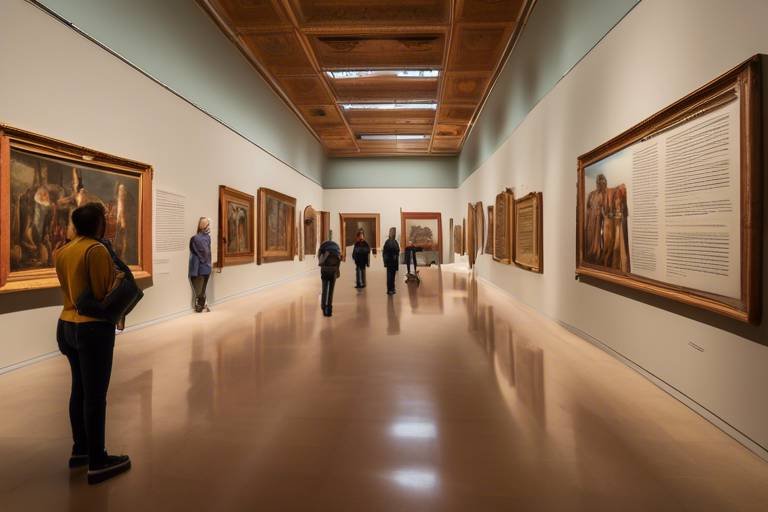The Effects of Climate Change on Archaeological Preservation
Climate change is not just a buzzword; it is a real and pressing issue that is impacting various aspects of our world, including the preservation of archaeological sites and cultural heritage. The effects of climate change on archaeological preservation are profound and multifaceted, posing significant challenges to the integrity, accessibility, and long-term survival of these invaluable historical resources.
One of the most visible impacts of climate change on archaeological sites is the rising sea levels, which present a significant threat to coastal areas. As sea levels continue to rise, coastal archaeological sites face erosion, inundation, and the potential loss of valuable historical artifacts and structures. The relentless force of the water poses a direct risk to the preservation of these sites, making them more vulnerable to destruction and decay.
Increased temperatures resulting from climate change also play a detrimental role in the preservation of archaeological materials, structures, and landscapes. Higher temperatures can accelerate the deterioration of these artifacts, leading to irreversible damage and loss of important historical information. The heat can compromise the conservation efforts and interpretation of archaeological sites, putting their cultural significance at risk.
Extreme weather events, such as storms, floods, and wildfires, have become more frequent and severe due to climate change. These events pose a direct threat to archaeological sites, causing physical damage and disrupting research efforts. The destructive power of these natural disasters can obliterate centuries-old artifacts and structures, making it challenging to protect and study our shared cultural heritage.
Permafrost thaw in Arctic regions is another consequence of climate change that impacts archaeological sites. As the frozen ground thaws, it exposes new artifacts while also subjecting previously preserved materials to decay. This rapid transformation of the landscape poses a unique set of challenges for archaeologists, requiring innovative approaches to salvage and document the newly revealed treasures.
Changes in precipitation patterns due to climate change can destabilize archaeological sites, leading to soil erosion, landslides, and the exposure of buried artifacts. The shifting climate conditions alter the physical environment of these sites, making them more susceptible to damage and degradation. The delicate balance of preservation is further compromised as the natural elements take their toll on these historical treasures.
Moreover, the shifts in plant and animal habitats resulting from climate change have a ripple effect on the context and ecosystem of archaeological sites. These changes influence the interpretation and conservation of these sites, as the surrounding environment plays a crucial role in understanding their historical significance. The interconnectedness of nature and culture underscores the importance of addressing climate change to safeguard our archaeological heritage.
Climate change-induced loss of traditional knowledge and practices related to archaeological sites poses a significant threat to their management and interpretation. As communities lose their connection to the land and heritage due to changing environmental conditions, the preservation efforts become more challenging. The rich tapestry of stories and traditions associated with these sites is at risk of being lost forever if proactive measures are not taken to address the impact of climate change.
In light of these challenges, it is essential to explore mitigation strategies and adaptation measures to safeguard archaeological sites in the face of climate change. Monitoring the impact of climate change on these sites, implementing conservation techniques, and engaging local communities in the preservation efforts are crucial steps towards ensuring the long-term survival of our cultural heritage. By taking proactive measures and working together, we can protect and preserve our archaeological treasures for future generations to cherish and learn from.

Rising Sea Levels
Rising sea levels present a significant threat to coastal archaeological sites around the world. As global temperatures increase, polar ice caps and glaciers melt, causing the oceans to expand and encroach upon land. This phenomenon leads to the erosion, inundation, and ultimately, the loss of valuable historical resources that are situated near coastlines.
Archaeological sites located in low-lying areas are particularly vulnerable to the effects of rising sea levels. The gradual submersion of these sites underwater can result in the destruction of structures, artifacts, and cultural remains that have been preserved for centuries. Additionally, the increased salinity of the water can accelerate the decay of organic materials, further compromising the integrity of these archaeological treasures.
Coastal erosion, exacerbated by higher sea levels, can also lead to the loss of stratigraphic layers that provide valuable insights into past civilizations. As the waves erode the shorelines, archaeological evidence may be washed away, making it challenging for researchers to piece together the history and cultural significance of these sites.
Moreover, the threat of rising sea levels extends beyond the physical destruction of archaeological sites. The loss of these cultural heritage locations not only deprives future generations of their historical roots but also diminishes our understanding of the past and the lessons it offers for the present and future.

Increased Temperatures
When it comes to the impact of on archaeological preservation, the consequences are significant and far-reaching. Elevated temperatures can lead to accelerated deterioration of archaeological materials, structures, and landscapes, posing a serious threat to their long-term conservation and interpretation.
The scorching heat can cause fragile artifacts to degrade at a faster rate, weakening their integrity and making them more susceptible to damage. Stone structures may suffer from thermal stress, leading to cracks and fractures that compromise their stability over time. Additionally, the parched landscapes resulting from higher temperatures can exacerbate the risk of wildfires, putting archaeological sites at risk of destruction.
Moreover, the impact of increased temperatures extends beyond the physical realm. As the climate warms, the ecological balance of archaeological sites may shift, affecting the flora and fauna that inhabit these areas. This disruption can alter the context in which artifacts are found, complicating the interpretation of past human activities and lifestyles.
Furthermore, rising temperatures can also impact the accessibility and safety of archaeological sites, especially those located in arid regions. The scorching heat can make excavation and conservation efforts more challenging, requiring additional resources and specialized techniques to mitigate the effects of climate change.
In essence, the rise in temperatures due to climate change poses a multifaceted challenge to the preservation of archaeological sites and cultural heritage. It underscores the urgent need for proactive measures to safeguard these invaluable resources for future generations.

Extreme Weather Events
Extreme weather events present a significant threat to archaeological sites worldwide, posing challenges to their preservation and research. Storms, floods, and wildfires, intensified by climate change, can cause extensive physical damage to delicate structures and artifacts, disrupting ongoing excavations and conservation efforts. The unpredictability and severity of these events make it difficult for archaeologists to safeguard valuable historical resources and gather essential data for interpretation.

Permafrost Thaw
Permafrost thaw, a consequence of climate change, is significantly impacting Arctic archaeological sites. As the frozen ground melts, it unveils new artifacts that were previously hidden beneath the ice for centuries. This sudden exposure provides archaeologists with a unique opportunity to discover and study ancient materials that were once inaccessible. However, the thawing of permafrost also poses a threat to the preservation of these artifacts, as the sudden change in temperature and moisture levels can lead to rapid decay and deterioration.
Imagine permafrost as a time capsule preserving the history of past civilizations. Just like an explosion, the thawing of permafrost reveals a treasure trove of information, offering a glimpse into the lives of ancient peoples. However, this explosion of new discoveries comes with the risk of losing valuable insights due to the fragile nature of the exposed artifacts. The delicate balance between preservation and exposure is crucial in ensuring that these archaeological sites remain intact for future generations to explore and learn from.
Archaeologists and conservationists are faced with the challenge of developing innovative preservation techniques to protect the newly exposed artifacts from rapid deterioration. Methods such as stabilizing the soil, controlling moisture levels, and implementing protective coverings are being explored to mitigate the impact of permafrost thaw on archaeological sites. Additionally, ongoing monitoring and research are essential to track the changes occurring within these fragile environments and adapt conservation strategies accordingly.
The thawing of permafrost not only affects the physical preservation of artifacts but also has broader implications for the cultural heritage of indigenous communities. As ancient materials resurface, traditional knowledge and practices tied to these sites may also be at risk of being lost or altered. The connection between the land, history, and identity of indigenous peoples is deeply intertwined with these archaeological sites, making it crucial to involve local communities in the preservation and interpretation efforts.

Changes in Precipitation Patterns
Changes in precipitation patterns due to climate change have significant implications for the preservation of archaeological sites. Alterations in rainfall intensity and distribution can impact the stability of these sites, leading to various challenges in their conservation and interpretation. Increased precipitation may result in soil erosion, potentially exposing fragile artifacts to the elements and accelerating their decay. On the other hand, prolonged droughts can cause the desiccation of archaeological materials, compromising their structural integrity.
The shifting precipitation patterns can also trigger landslides in archaeological areas, disrupting the landscape and potentially burying valuable remains under layers of debris. This poses a threat to the accessibility and visibility of these sites, complicating efforts to study and protect them. Moreover, sudden heavy rainfall events can lead to flash floods, washing away surface artifacts and eroding the stratigraphy essential for understanding the site's chronological sequence.
Archaeologists and conservationists must closely monitor the effects of changing precipitation patterns on archaeological sites and implement adaptive strategies to mitigate potential damage. This may involve the construction of drainage systems to prevent water accumulation, the application of protective coatings on exposed artifacts to shield them from moisture, and the development of sustainable landscaping to reduce erosion risks. By integrating weather data and predictive modeling into site management plans, stakeholders can better anticipate and respond to the evolving challenges posed by climate-induced shifts in precipitation.

Shifts in Plant and Animal Habitats
Climate change is not only altering the temperature of the planet but also reshaping the habitats of plants and animals. These shifts in plant and animal habitats are having a profound impact on archaeological sites, influencing the context and ecosystem in which they exist. Imagine a forest that once surrounded an ancient settlement slowly transforming into a savanna due to changing climate patterns. Such alterations not only affect the appearance of the site but also the resources available for research and conservation efforts.
As plant species migrate to more suitable environments and animal populations adjust their ranges, the composition of archaeological sites undergoes significant transformations. The plants that once provided clues about ancient diets or medicinal practices may disappear, while new species previously unseen in the area start to appear. This shift in biodiversity can complicate the interpretation of archaeological findings, requiring experts to adapt their methods and analysis to the changing landscape.
Moreover, the habitat modifications caused by climate change can lead to the degradation of archaeological structures and materials. Imagine a temple complex built amidst lush vegetation now exposed to harsh sunlight and invasive species due to habitat shifts. The once-stable environment that supported the preservation of these structures is now under threat, accelerating their decay and necessitating urgent conservation measures to prevent irreversible damage.
Furthermore, the presence of new plant and animal species in archaeological sites can alter the delicate balance of ecosystems, potentially introducing invasive species that disrupt the natural heritage of the area. This disruption not only affects the archaeological remains themselves but also the surrounding environment, impacting the overall conservation efforts and sustainability of the site. It becomes crucial for archaeologists and conservationists to monitor these shifts closely and develop adaptive strategies to mitigate their adverse effects.

Loss of Traditional Knowledge
Climate change not only impacts the physical aspects of archaeological sites but also poses a significant threat to the traditional knowledge and practices associated with them. As global temperatures rise and ecosystems shift, the indigenous knowledge passed down through generations faces the risk of being lost forever. The intimate connection between local communities and archaeological sites is deeply rooted in traditional beliefs, rituals, and oral histories that provide invaluable insights into the past.
Imagine a tapestry woven with threads of ancient wisdom, cultural traditions, and ecological understanding. This intricate fabric of knowledge is at risk of unraveling as climate change disrupts the delicate balance between humans and their environment. The loss of traditional knowledge not only hinders our ability to interpret archaeological findings but also diminishes the cultural heritage that shapes our identities and connects us to our ancestors.
One of the most significant challenges posed by the loss of traditional knowledge is the impact on community engagement and stewardship of archaeological sites. Indigenous communities play a vital role in the preservation and interpretation of cultural heritage, drawing on centuries-old practices to protect and honor the legacy of their ancestors. As climate change erodes this foundation of knowledge, the bond between communities and archaeological sites weakens, jeopardizing the sustainable management and conservation of these invaluable resources.
Efforts to address the loss of traditional knowledge in the face of climate change require a holistic approach that combines scientific research with community empowerment and cultural revitalization. By engaging local stakeholders in conservation initiatives, fostering intergenerational dialogue, and supporting the transmission of traditional practices, we can safeguard not only the physical remnants of the past but also the intangible heritage that enriches our understanding of history and human experience.

Mitigation Strategies and Adaptation Measures
When it comes to mitigating the effects of climate change on archaeological preservation, various strategies and adaptation measures can be implemented to safeguard cultural heritage for future generations. One crucial approach is the implementation of monitoring systems to track environmental changes and their impact on archaeological sites. By closely monitoring factors like temperature, precipitation, and sea levels, researchers and conservationists can proactively address potential threats and take necessary actions to protect vulnerable sites.
Additionally, utilizing advanced conservation techniques plays a vital role in preserving archaeological materials and structures in the face of changing climatic conditions. Innovations in conservation science, such as stabilizing fragile artifacts, reinforcing deteriorating structures, and implementing climate-controlled storage facilities, can help mitigate the detrimental effects of climate change on archaeological sites.
Furthermore, engaging local communities in the protection and management of archaeological sites is essential for long-term preservation efforts. By involving community members in conservation projects, educational initiatives, and sustainable tourism practices, a sense of ownership and responsibility is fostered, leading to increased awareness and support for preserving cultural heritage in the midst of climate challenges.
Incorporating traditional knowledge and practices of indigenous peoples and local communities can also enhance adaptation measures for archaeological preservation. Drawing upon centuries-old techniques for sustainable land use, resource management, and site maintenance, traditional knowledge offers valuable insights into harmonizing human activities with the environment, ensuring the resilience of archaeological sites against climate-related threats.
Moreover, establishing partnerships between governmental agencies, academic institutions, non-profit organizations, and indigenous communities is crucial for developing comprehensive strategies to address the impacts of climate change on archaeological heritage. Collaborative efforts can lead to the exchange of expertise, resources, and best practices, fostering a holistic approach to conservation and adaptation that transcends geographical and disciplinary boundaries.
Frequently Asked Questions
- What are the main threats that climate change poses to archaeological sites?
Climate change poses various threats to archaeological sites, including rising sea levels leading to erosion and inundation, increased temperatures accelerating material deterioration, extreme weather events causing physical damage, permafrost thaw exposing artifacts to decay, changes in precipitation patterns leading to soil erosion, and shifts in plant and animal habitats altering site ecosystems.
- How does climate change impact the preservation of cultural heritage?
Climate change impacts the preservation of cultural heritage by compromising the integrity, accessibility, and long-term survival of archaeological sites and artifacts. It accelerates decay processes, causes physical damage through severe weather events, and disrupts the conservation efforts of valuable historical resources.
- What are some mitigation strategies to safeguard archaeological sites from the effects of climate change?
Mitigation strategies include implementing monitoring systems to track changes, utilizing conservation techniques to protect materials, and involving local communities in the preservation of cultural heritage. These strategies aim to reduce the impact of climate change on archaeological sites and ensure their sustainable conservation.



















